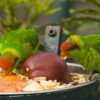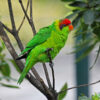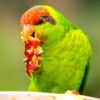DID YOU KNOW?
The Iris Lorikeet has a strongly built beak, more so than most lories and lorikeets. It is speculated that this may be an adaptation for a unspecified item in its diet.

Trichoglossus

iris
Size:
20 cm (7.8 in)
Weight:
65-75 g (2.3-2.6 oz)
Subspecies including nominate:
three: T.i. iris, T.i. rubripileum, T.i. wetterensis
Colour Adult:
T.i. iris: Both adults in general yellow/green; red forecrown and area above eye, in female less extensive and lighter; purple/blue band from area behind eye to ear coverts; sides of hindneck purple/blue; pale grey/blue occiput; nuchal collar yellow/green; yellow/green underparts barred with darker green. Beak orange/red. Eye orange.
T.i. rubripileum: Both adults forecrown to occiput red, with minimal grey/blue.
T.i. wetterensis: Both adults darker red forecrown with grey/blue mixed in; eye to ear coverts has darker purple band; dull red/brown wash on forecheeks with blue tint; darker barring on underparts; larger.
Colour Juvenile:
T.i. iris: As in adult female, but with less red on forecrown; band from behind eye to ear coverts duller. Beak brown. Eye brown.
T.i. rubripileum: As in adults.
T.i. wetterensis: As in adults.
Call:
Calls are a variety of screeches, some shrill, and whistles.
More Information:
Content Sources:
CITES
BirdLife International
Cornell Lab of Ornithology/Birds of the World
Parrots: A Guide to Parrots of the World, Juniper and Parr, 1998
Parrots: Status Survey and Conservation Plan 2000-2004, Snyder, McGowan, Gilardi, Grajal, 2000.
Parrots of the World, Forshaw, 2006. 2010 edition
Parrots in Aviculture, Low, 1992.
Lexicon of Parrots, Thomas Arndt.
Parrots: Their Care and Breeding, Low, 1986.
Captive Status:
Fairly rare
Longevity:
25 yrs or more.
Housing:
Aviary with concrete or tiled floor and washable walls, with a drain, or suspended enclosure with same, 2.5 x 1 x 2 m (8.2 x 3.3 x 6.5 ft).
Diet:
Nectar, a commercial type or one homemade from: lactose-free baby cereal, honey and malt extract or molasses, mixed with filtered water and made fresh once or twice daily, comprising about 5 to 10 percent of the diet; fruits such as: apple, pear, orange, banana, kiwi, pomegranate, cactus fruits; vegetables such as: carrot, fresh corn on the cob; green leaves such as: Swiss chard, lettuce, kale, sowthistle, dandelion, chickweed; dried figs soaked in water for a few hours; spray millet; small amount of soaked or sprouted sunflower seed and some canary seed and/or oats.
Enrichment:
Are vigorous chewers so provide bird-safe, unsprayed flowering, willow, elder, fir or pine branches; wooden block or vegetable tanned leather toys (remove promptly when soiled); heat sterilized pine cones. Also provide overhead misters or shallow, water filled bowls for bathing.
Nest Box Size:
Nest log or vertical box 8″ x 8″ x 16″ (20.3 cm x 20.3 cm x 40.6 cm).
Clutch Size:
2
Fledging Age:
8 weeks
Hatch Weight:
—
Peak Weight:
—
Weaning Weight:
—
World Population:
About 10,000 individuals, decreasing.
IUCN Red List Status:
Near Threatened
CITES Listing:
Appendix II
Threat Summary:
Not globally threatened. A BirdLife “restricted-range” species. The least common of the three lorikeets on Timor in recent decades, but presumably still relatively secure on a still partly forested and fairly large island; probably locally common at higher elevations. Could be facing declines from trapping.
Range:
T.i. iris: W Timor.
T.i. rubripileum: E Timor.
T.i wetterrensis: Wetar Island.
Habitat:
Found up to 1500 m (4920 ft) in monsoon forest, woodland, plantations and agricultural land with flowering trees.
Wild Diet:
Visits flowering trees including Sesbania. Recorded feeding in Eucalyptus alba and in tamarinds.
Ecology and Behaviour:
Seen in small groups; inconspicuous and shy. Occasionally seen in flocks of up to 50 individuals in heavily flowered trees.
Clutch and Egg Size:
2 eggs, 23.5 x 19.5 mm (0.9 x 0.7 in).
Breeding Season:
—
Related Links:
—
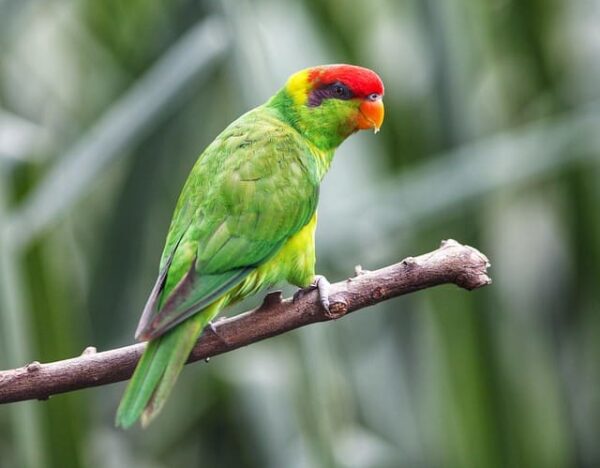
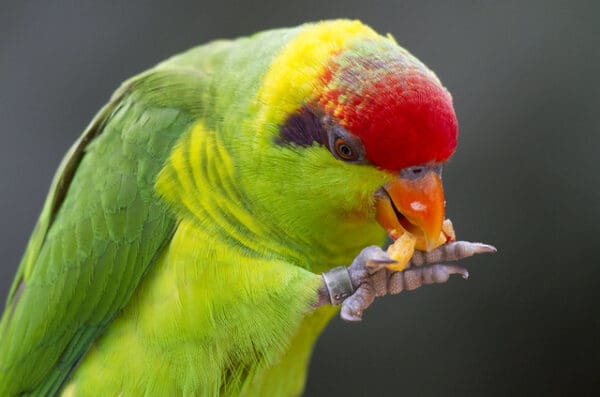
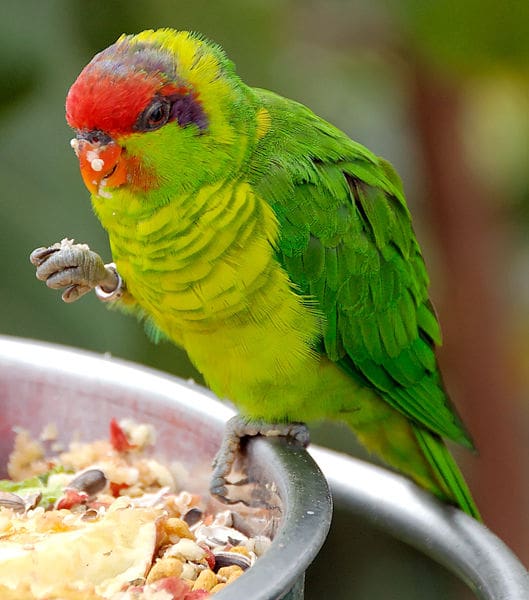
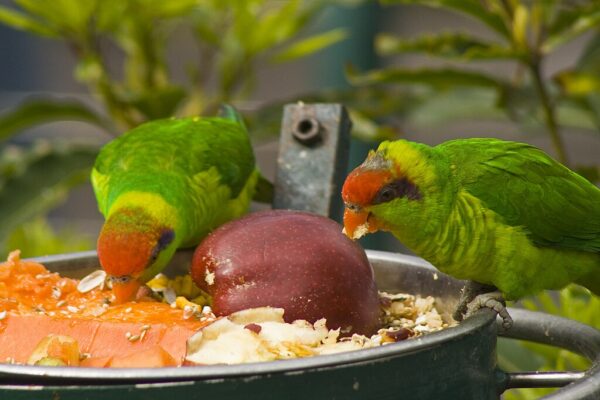
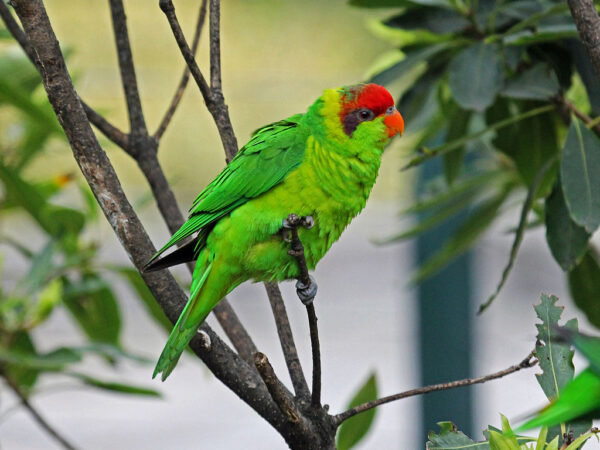
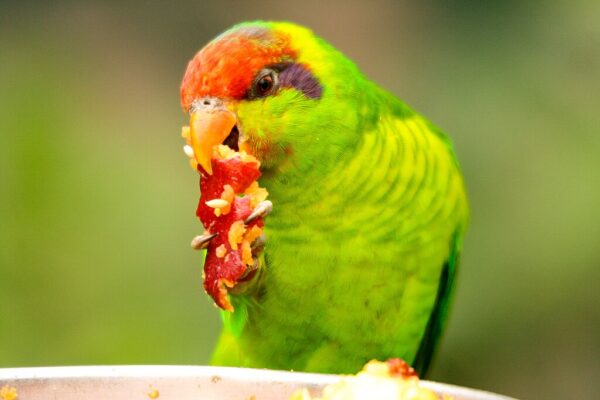
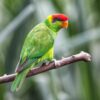
![© Nathan Rupert [CC BY-SA 2.0] via Flickr An Iris Lorikeet feeds at San Diego Zoo, USA](https://gt2024.parrots.org/wp-content/uploads/2023/01/wpt_Iris-Lorikeet_1232-9-100x100.jpg)
![© Evan Parker [CC BY-SA 2.0] via Wikimedia Commons An Iris Lorikeet feeds at San Diego Zoo, USA](https://gt2024.parrots.org/wp-content/uploads/2023/01/wpt_Iris-Lorikeet_1232-1-100x100.jpg)
